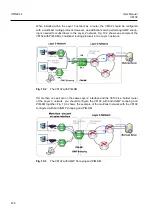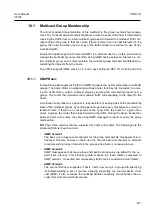
User Manual
UMN:CLI
V8102
463
9.11.2
CPU Flood Guard
CPU flood guard controls the number of broadcast and multicast packets per second,
which is coming to CPU to prevent CPU overload. If the number of those packets ex-
ceeds the threshold, the system generates an SNMP trap.
To enable/disable the CPU flood guard, use the following command.
Command
Mode
Description
cpu-flood-guard
{
enable
|
disa-
ble
}
Global
Enables/disables the CPU flood guard.
To specify the number of broadcast and multicast packets per second, which is coming to
CPU, use the following command.
Command
Mode
Description
cpu-flood-guard
<1-6000>
Interface
[XE/GE/GPON/CG]
Specifies the number of broadcast and mul-
ticast packets toward CPU per second.
1-6000: the number of packets per second
no cpu-flood-guard
Deletes a specified number of packets.
You can also enable the blocking option. When the blocking option for CPU flood guard is
running, if the number of incoming broadcast and multicast packets per second exceeds
a configured value, the port will discard those packets during a specified time.
To enable the blocking option, use the following command.
Command
Mode
Description
cpu-flood-guard
timer
<10-3600>
Interface
[XE/GE/
GPON/CG]
Enables the blocking option.
10-3600: blocking time (unit: second)
cpu-flood-guard
unblock
Forces the state of a blocked port to change to NOR-
MAL.
To display the configured CPU flood guard, use the following command.
Command
Mode
Description
show cpu-flood-guard
Enable
Global
Shows the configured CPU flood guard.
9.11.3
System Flood Guard
A packet flooding occurs unexpectedly when a large number of broadcast or multicast
packets are received on a port, which may cause unnecessary network congestion. The
V8102 provides the system flood guard function that controls traffic for a port by given
threshold. If the number of incoming packets exceeds the threshold, the system gener-
ates a syslog message/SNMP trap or discards those packets.
















































